
While most of us are aware of the massive U.S. intelligence network, we rarely see exactly how much this network costs taxpayers. In this posting, I want to look at the budget for the Department of Defense's Military Intelligence Program or MIP as well as the National Intelligence Program or NIP. Fortunately, in a June 2018 Congressional Research Service report on intelligence community spending, Micheal DeVine provides us with a detailed look at spending on both the National Intelligence Program and the Military Intelligence program so that we can put the budget requests for fiscal 2020 into context.
Let's open by looking at the component organizations of the U.S. intelligence community (effective 2018):
Here is a description of intelligence and intelligence-related activities that are part of the United States' intelligence community:
"1.) The collection, analysis, production, dissemination, or use of information that relates to a foreign country, or a government, political group, party, military force, movement, or other association in a foreign country, and that relates to the defense, foreign policy, national security, or related policies of the United States and other activity in support of the collection, analysis, production, dissemination, or use of such information;
2.) Activities taken to counter similar activities directed against the United States;
3.) Covert or clandestine activities affecting the relations of the United States with a foreign government, political group, party, military force, movement, or other association;
4.) Collection, analysis, production, dissemination, or use of information about activities of persons within the United States, its territories and possessions, or nationals of the United States abroad whose political and related activities pose, or may be considered by a department, agency, bureau, office, division, instrumentality, or employee of the United States to pose, a threat to the internal security of the United States; and
5.) Covert or clandestine activities directed against persons within the United States, its territories and possessions, or nationals of the United States abroad whose political and related activities pose, or may be considered by a department, agency, bureau, office, division, instrumentality, or employee of the United States to pose, a threat to the internal security of the United States."
According to the author, the two programs are defined as follows:
1.) National Intelligence Program – supports strategic planning and policymaking. There are 4 defense and 8 nondefense NIP programs.
2.) Military Intelligence Program – supports military operational and tactical levels of planning and operations. There are 10 MIP programs.
Six of America's intelligence community components have both NIP and MIP funding. In total, spending on intelligence has remained relatively constant over the past decade, representing approximately 11 percent of the total defense budget. It is important to keep in side that the combined NIP and MIP budgets do not encompass all of Washington's spending on intelligence; other government departments have their own intelligence-gathering entities that fall outside of both NIP and MIP.
Other than the topline budget numbers, most intelligence dollars are classified for security reasons. This creates a situation where there is little reason for America's intelligence community to be accountable for their budgets since the numbers and activities are hidden. At present, only the topline NIP figure must be disclosed; details including which intelligence agency or which intelligence program is receiving funds is secret.
Here is a table showing topline spending on intelligence activities from fiscal 2007 to fiscal 2019:
Here is a graphic showing intelligence spending as a percentage of the national defense budget over the same timeframe:
Here is a table from the Department of National Intelligence showing the breakdown for the NIP and MIP budgets (both requested and appropriated) going back to 2006:
Now, let's look ahead in time to fiscal 2020. Here is the fiscal 2020 National Intelligence Program budget request announcement:
At $62.8 billion, the request for fiscal 2020 is the highest in terms of nominal dollars and is 4.8 percent above the request for fiscal 2019.
Now, let's look at this year's highly secret black budget request for America's Military Intelligence Program since it is not shown on the table above. According to Defense News, the Pentagon has requested $22.95 billion for the top-line budget of the MIP for fiscal 2020. This includes the base budget and overseas contingency operations funding. This increase of 7.6 percent is the fifth straight year that the Department of Defense has requested a budget increase for intelligence programs.
From this posting, we can see that the combined intelligence community budget of $85.75 billion will be the highest on record (in nominal dollars). By way of comparison, here are the budgets for fiscal 2020 budget for the following departments:
Department of Agriculture – $20.8 billion
Department of Education – $62 billion
Department of Energy – $31.7 billion
Department of Health and Human Services – $87.1 billion
Department of Housing and Urban Development – $44.1 billion
When you compare spending on agriculture, education and health services, it becomes abundantly clear that spending on America's intelligence network is a priority for Washington. We can also see one other thing; America's intelligence community certainly knows how to spend tens of billions of dollars with minimal oversight.
Click HERE to read more from this author.
You can publish this article on your website as long as you provide a link back to this page.

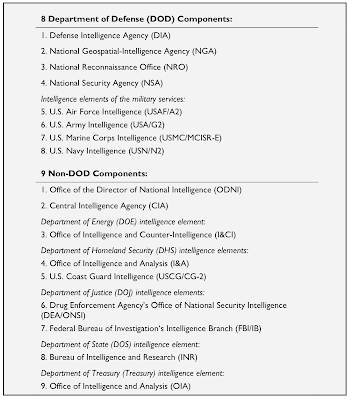
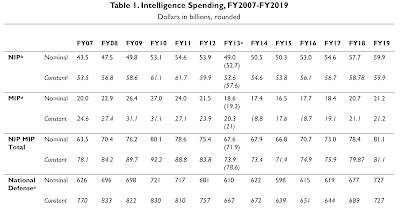
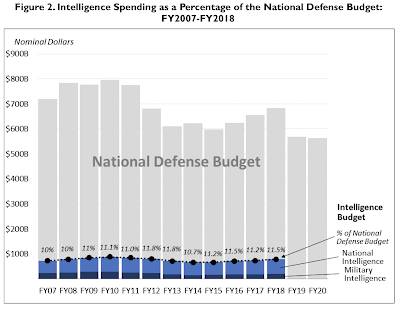
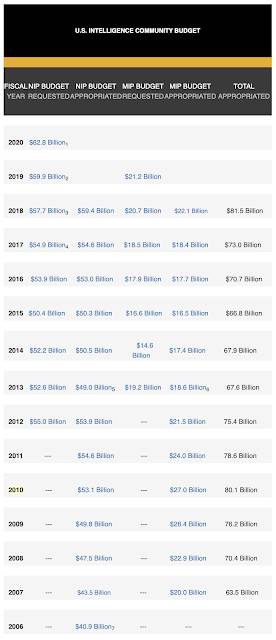
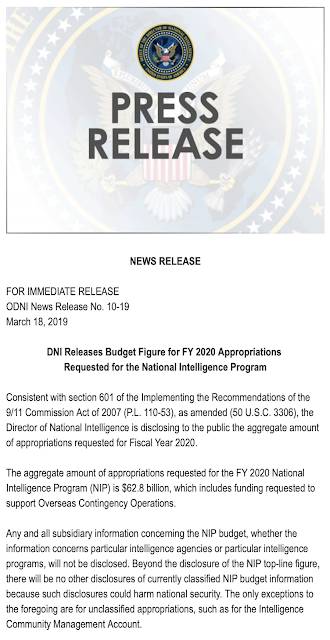
Be the first to comment